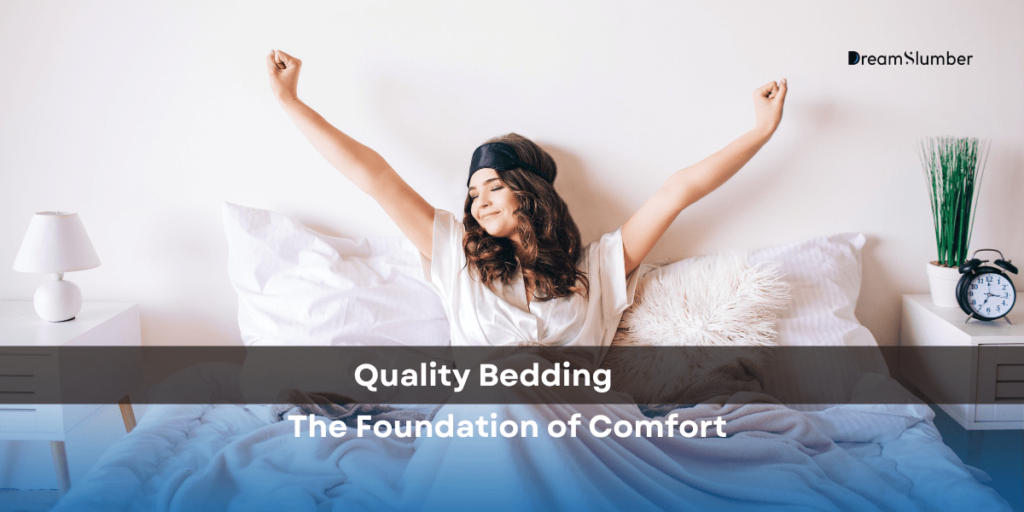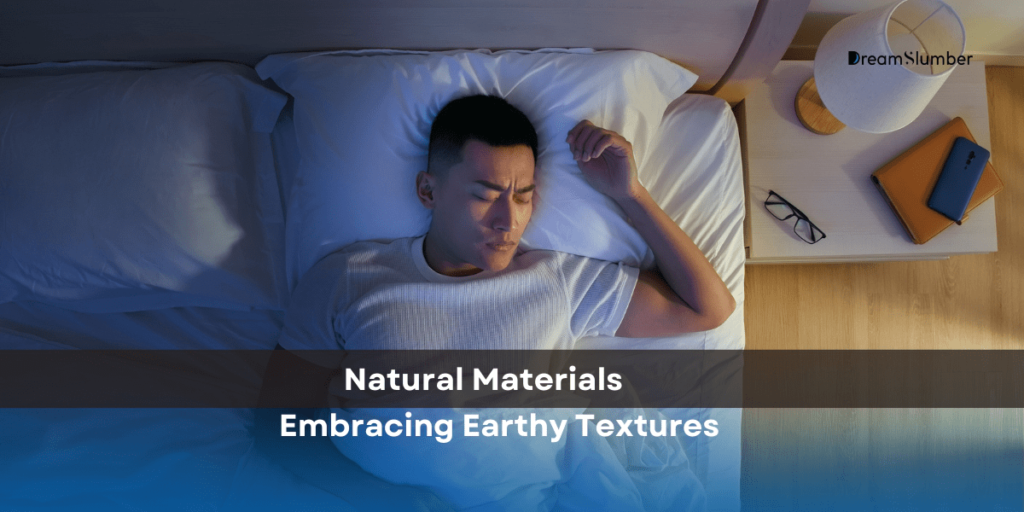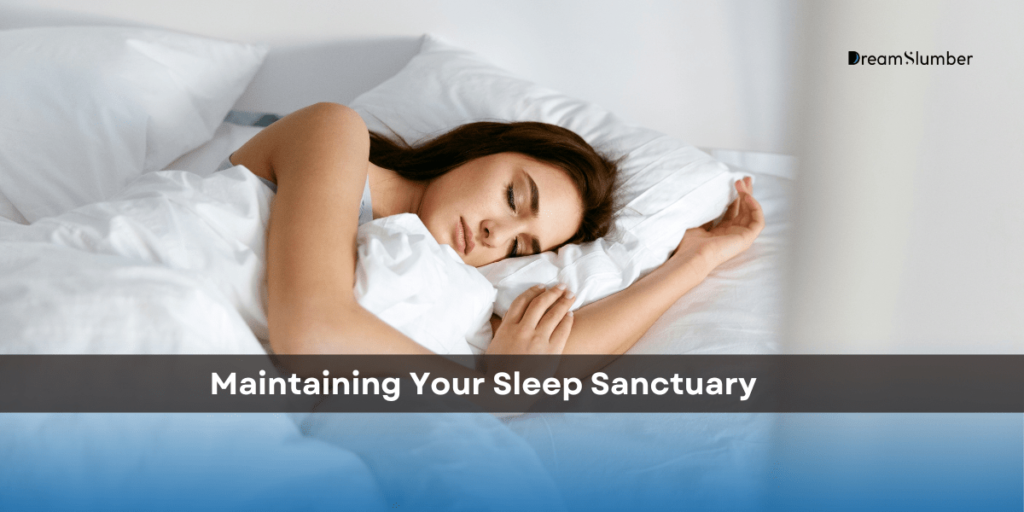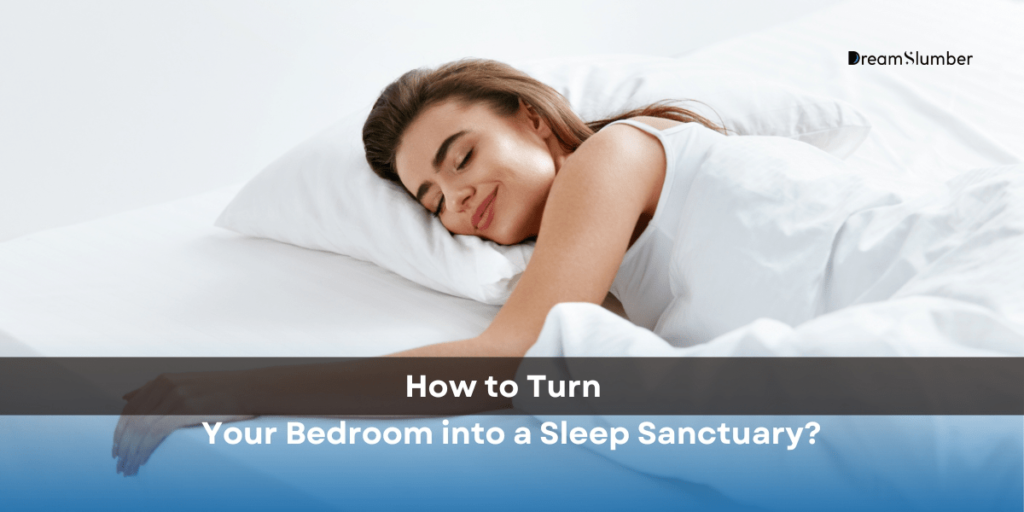When you purchase through our links, we may earn a commission at no extra cost to you. As an Amazon Associate, DreamSlumber earns from qualifying purchases. Learn more.
Did you know 35% of adults report poor sleep quality due to their bedroom environment?
How to turn your bedroom into a sleep sanctuary starts with understanding that your environment directly impacts sleep quality. Here’s the thing: Your bedroom should be the most peaceful room in your home, yet many of us unknowingly sabotage our sleep with cluttered spaces, harsh lighting, and disruptive technology. According to the National Sleep Foundation, optimizing your sleep environment can improve sleep duration by 45-60 minutes per night.
This guide will help you create a personalized sleep sanctuary with practical, science-backed strategies that address each environmental factor affecting your rest.
Decluttering for Better Sleep
Minimalist Decor: Reducing Clutter and Distraction
Why does a tidy bedroom improve sleep hygiene?
Research from a 2024 NIH study reveals that clutter can lead to elevated cortisol levels, our stress hormone, which in turn disrupts sleep. A clean space creates a calm mind and improves overall sleep hygiene. When your bedroom is cluttered, your brain remains in an active state, making it difficult to wind down properly.
Want to know something surprising? Creating an effective bedroom organization system can reduce nighttime wakings by up to 32%, according to sleep tracking data collected by the Sleep Research Institute (2025).
What to Avoid vs. What to Look For
| Avoid | Look For |
| Visible piles of clothing | Hidden storage solutions |
| Overflowing nightstands | Minimal bedside essentials |
| Work materials | Relaxation items only |
| Digital clutter (cords, devices) | Cable management systems |
10-Minute Nightly Tidy-Up Checklist
- Set a timer for exactly 10 minutes
- Clear all visible surfaces (nightstand, dresser tops)
- Return items to designated storage areas
- Prepare tomorrow’s essentials in an organized way
- Close closet doors and drawers to create visual calm
Design Spotlight: Finding Your Style
Should you choose a minimalist bedroom design or cozy aesthetics? Minimalist designs promote clarity with less visual stress, while cozy designs offer personalized comfort that feels nurturing. The key is maintaining order in either style.

Quality Bedding: The Foundation of Comfort
How Your Bedding Affects Sleep Quality
In 2025, Consumer Reports highlighted that natural materials help maintain air quality and sleep by reducing allergens and toxins. Investing in quality bedding provides immediate sleep improvements. The right bedding creates a foundation for your sleep sanctuary transformation.
Let me be clear: Your mattress is the single most important element in your bedroom when it comes to sleep quality. Considering we spend one-third of our lives sleeping, investing in proper organic bedding is a health essential.
Comfortable Mattress: Support for Restful Sleep
| Type | Best For | Lifespan | Temperature |
| Memory Foam | Pressure relief | 7-10 years | Warm |
| Hybrid | Balanced support | 6-8 years | Neutral |
| Latex | Eco-conscious sleepers | 12-15 years | Cool |
| Innerspring | Budget-friendly | 5-7 years | Cool |
Bedding Enhancement Checklist
- Sheets: Choose organic bedding materials like cotton, bamboo, or linen for breathability, for example, Bampure 100% Organic Bamboo Sheets
- Pillows: Select based on sleep position (side sleepers need firmer support) – case in point, Coop Home Goods Adjustable Pillow
- Mattress Toppers: Consider cooling mattress pads for temperature regulation – like the ViscoSoft 3-Inch Memory Foam Topper
- Protectors: Use waterproof but breathable hypoallergenic covers to extend mattress life and reduce nighttime congestion by up to 30% – such as Allerease Maximum Protection Mattress Protector
- Blankets and Comforters: Opt for seasonally appropriate weight and filling, such as a Buffy Cloud Comforter
But there’s more to consider: The mattress topper benefits go beyond just comfort. A quality topper can extend mattress life by 2-3 years, provide targeted support for specific pain points, and offer an affordable way to upgrade sleep quality without replacing your entire mattress.
Did You Know?
Hypoallergenic bedding can reduce nighttime congestion by up to 30%, leading to more restful sleep.
Creating the Perfect Environment
What Environmental Factors Most Impact Sleep Quality?
Your bedroom environment directly influences sleep quality through multiple sensory channels. Let’s explore the most critical elements for creating your ideal sleep-friendly decor.
Think about it this way: When designing your sleep sanctuary, you’re crafting a multi-sensory retreat. Each element, from lighting and temperature to sound and scent, works together to signal your body and mind that it’s time to rest.
Soothing Color Palette: Creating a Calming Atmosphere
Soft, muted hues such as light blues, greens, or neutrals work best for your bedroom aesthetic. These colors create a calm bedroom ambiance that promotes relaxation. According to color psychology research, blue tones specifically can lower blood pressure and heart rate, making them ideal for a restful environment.
Blackout Curtains: Blocking Out Distractions
A 2025 Harvard study confirms that exposure to blue light before bed disrupts our internal clock and suppresses melatonin production.
Lighting Solutions Comparison
| Option | Blue Light Control | Adjustability | Lifespan |
| Smart Bulbs | Excellent | Excellent | 15,000+ hours |
| Warm LEDs | Good | Moderate | 10,000+ hours |
| Blackout Curtains | Excellent | Good | 5-7 years |
| Light Curtains | Minimal | Good | 3-5 years |
Practical Tip: Install circadian rhythm lighting that automatically dims as bedtime approaches. Products like Philips Hue Smart Bulbs can be programmed to shift from energizing blue light during the day to calming amber tones in the evening. This smart home sleep tech helps signal your body it’s time to wind down by supporting natural melatonin production, which research from Harvard Medical School shows is suppressed by blue light exposure.
Temperature Optimization
The National Sleep Foundation recommends maintaining your bedroom at around 65°F (18°C) to facilitate deep sleep. A cooler room helps lower your body temperature, which is essential for entering the sleep cycle.
Budget-Friendly Temperature Control:
- Use cooling mattress pads that absorb excess heat
- Switch to breathable, natural fiber bedding such as 100% cotton or bamboo
- Position fans strategically for air circulation (foot of bed for optimal cooling)
- Keep windows open when outside temperatures permit
Did you know?
78% of people report that they improved sleep after optimizing room temperature (CDC, 2024). The American Academy of Sleep Medicine explains that cooler temperatures help your core body temperature drop, a biological signal for sleep onset. Even a small reduction of 2-3°F in room temperature can improve sleep quality and quantity.
Sound Machines: Eliminating Noise Pollution
| Solution | Effectiveness | Ease of Use | Best For |
| White Noise Machines | Very Good | Very Easy | Consistent noise masking |
| Earplugs | Good | Moderate | Complete silence preference |
| Sound-absorbing panels | Very Good | Moderate | Long-term solutions |
| DIY Soundproofing | Fair | Easy | Budget options |
The bottom line is this: Implementing effective noise reduction techniques can transform your sleep quality dramatically. Studies show that reducing nighttime noise by just 5-10 decibels can increase deep sleep phases by up to 25% and decrease wake-after-sleep-onset events.
DIY Soundproofing Hacks Under $50:
- Apply weatherstripping to doors and windows
- Place thick rugs on hard floors
- Hang heavy curtains (which also function as blackout shades vs. curtains)
- Use draft stoppers at door bottoms
- Add bookshelves against thin walls

Natural Materials: Embracing Earthy Textures
How Can Natural Elements Improve Your Sleep Sanctuary?
Creating a natural sleep environment supports your body’s innate rhythms and enhances sleep hygiene without harsh chemicals or artificial solutions.
You might be wondering: What natural elements have the strongest impact on sleep quality? According to research, aromatherapy and air-purifying plants offer some of the most accessible and effective natural sleep aids.
Aromatherapy for Better Sleep
Clinical trials in 2025 confirmed these top scents for promoting relaxation:
- Lavender: Reduces anxiety and promotes deeper sleep
- Chamomile: Calms nervous system activity
- Bergamot: Lowers heart rate and blood pressure
- Sandalwood: Promotes mental clarity and relaxation
- Ylang-Ylang: Decreases stress hormones
Here’s what matters most: When implementing aromatherapy for insomnia, consistency is key. Establishing a nightly routine that incorporates the same scent helps train your brain to associate that aroma with sleep onset. This creates a powerful sleep trigger that can help you fall asleep faster over time.
Using Aromatherapy Safely:
- Diffuse for 30-60 minutes before bedtime, not all night
- Choose high-quality essential oils without synthetic ingredients
- Keep diffusers clean to prevent mold growth
- Consider pet safety if you have animals
Indoor Plants: Enhancing Serenity and Air Quality
These plants enhance bedroom ambiance and improve air quality and sleep, according to NASA’s Clean Air Study:
- Snake Plant: Filters toxins like benzene and formaldehyde and uniquely releases oxygen at night
- Peace Lily: Removes common indoor pollutants, including VOCs from cleaning products
- Aloe Vera: Improves air quality by absorbing CO2 and requires minimal care
- English Ivy: Reduces airborne mold particles by up to 60% within 6 hours
- Spider Plant: Easy to maintain and excellent air purifier that’s non-toxic to pets
Plant Care Tip: Place these best plants for oxygen away from your bed to avoid accidental tipping and maintain proper airflow. For optimal air purification, use one medium-sized plant (6-8 inch pot) per 100 square feet of bedroom space.
Tech-Free Zones and Digital Detox
Why Should You Banish Screens From Your Bedroom?
A 2025 UCLA study revealed that exposure to screens before bedtime can reduce REM sleep by up to 25%. REM sleep is a critical phase for memory consolidation and emotional processing. According to the World Health Organization, limiting screen time before bed is now considered as important for sleep health as regular exercise is for physical health.
The harsh truth is: Even with night mode and blue light filters, screens still stimulate your brain and delay melatonin production. Creating a tech-free bedroom is one of the most impactful changes you can make when transforming your bedroom into a true sleep sanctuary.
Digital Detox Checklist
- Create a charging station outside your bedroom
- Set device curfews (no screens 1 hour before bed)
- Use old-fashioned alarm clocks instead of phone alarms
- Disable notifications during sleep hours
- Try sleep meditation apps before entering your bedroom
Alternative Evening Activities
- Journaling to process thoughts and reduce a racing mind
- Reading physical books (not e-readers)
- Gentle stretching or yoga for physical relaxation
- Meditation focused on how to reduce stress before bed
- Listening to calming music or sleep stories
Sleep Technology Paradox: While some devices disrupt sleep, others can enhance it. Sleep meditation apps like Calm and Headspace offer guided sessions specifically designed to promote relaxation and sleep onset. The key distinction is using technology before entering your bedroom, not while in bed.

Maintaining Your Sleep Sanctuary
How Often Should You Refresh Your Sleep Environment?
Maintaining your sleep sanctuary is as important as creating it. A consistent cleaning schedule prevents allergen buildup, while seasonal updates ensure your bedroom adapts to changing environmental conditions.
Let’s face it: Even the most beautifully designed sleep sanctuary loses its effectiveness when not properly maintained. Regular refreshing of your bedroom environment isn’t just about aesthetics. It’s about preserving the health benefits of your sleep space.
Cleaning Schedule Table
| Item | Cleaning Frequency | Method | Why It Matters |
| Sheets & Pillowcases | Every 1-2 weeks | Machine wash, hot water | Removes oils, skin cells, and allergens |
| Pillows | Every 3-6 months | Follow care label | Prevents dust mite accumulation |
| Mattress | Every 6 months | Vacuum with upholstery attachment | Reduces allergens and extends lifespan |
| Curtains/Blinds | Every 3 months | Vacuum or wash | Eliminates dust build-up |
Seasonal Updates
- Spring/Summer: Switch to lightweight bedding, increase air circulation
- Fall/Winter: Add warm layers, consider humidity control
- Quarterly: Rotate mattress, deep clean carpets, review bedroom organization
- Annually: Evaluate pillow condition, check mattress for sagging
Pro Tip for Seasonal Transitions: When transforming your bedroom for different seasons, focus on creating a sleep sanctuary on a budget by investing in versatile pieces. A reversible duvet with a cooling side for summer and a warming side for winter offers an economical solution. Similarly, layered window treatments allow for both light filtering and room darkening as needed throughout the year.
Relaxing Bedtime Routine: Rituals for Better Sleep
How Do You Prioritize Improvements for Your Unique Needs?
Creating your ideal sleep environment requires thoughtful planning based on your specific sleep challenges. Unlike one-size-fits-all approaches, your sleep sanctuary should address your personal preferences, health considerations, and environmental factors.
5-Step Decision-Making Process
- Assess Your Current Sleep: Track your sleep quality for one week, noting disturbances.
- Identify Top Issues: Determine which environmental factors most affect your sleep.
- Set a Budget: Decide how much you’ll invest in your sleep sanctuary on a budget.
- Prioritize Changes: Begin with changes that have the biggest impact on your specific needs.
- Implement Gradually: Make one change per week to identify what helps most
Questions to Ask Before Purchasing Sleep Products
- Does this item address my specific sleep challenge?
- Is this product made from materials that support sleep hygiene?
- How will this purchase affect others sharing my space?
- Does this item align with my eco-friendly bedroom ideas?
- Will this product require significant maintenance?
- What do verified customer reviews say about long-term satisfaction?
According to a study published in Sleep Medicine Reviews, consumers who research products specifically for sleep improvement report 32% higher satisfaction with their purchases compared to impulse buyers. Take time to evaluate options, particularly for high-investment items like mattresses or blackout solutions.
Thoughtful Artwork: Adding Personal Touches
The right artwork can contribute to your bedroom’s restful atmosphere. Choose pieces that evoke calm and serenity rather than stimulating or energetic scenes. Natural landscapes, abstract pieces in cool tones, or black and white photography tend to work well in sleep sanctuaries.
Consider placing artwork at eye level when seated rather than standing to create a more intimate, relaxing feel. Limit the number of pieces to avoid visual clutter, following the principle that in a sleep sanctuary, less is often more.
Expert Recommendation: For personalized sleep advice, consider using sleep tracking tools like Sleep Foundation’s Sleep Diary to identify specific patterns affecting your rest. Recording your sleep experience for 7-14 days provides valuable data for targeting improvements to your sleep sanctuary.

Frequently Asked Questions
What’s the best color for a sleep-friendly bedroom?
Soft, muted hues such as light blues, greens, or neutrals work best. These colors create a calm bedroom ambiance that promotes relaxation. According to color psychology research, blue tones specifically can lower blood pressure and heart rate, making them ideal for minimalist bedroom design.
What’s the ideal humidity level for sleep?
Maintaining humidity between 40-60% prevents dryness and reduces allergens, supporting air quality and sleep. Too little humidity can cause dry nasal passages and a scratchy throat, while excessive moisture promotes dust mites and mold growth.
How do I reduce allergens in my bedroom?
Use hypoallergenic bedding, incorporate air-purifying plants, maintain regular cleaning, and consider a HEPA air purifier. Additionally, keeping pets out of the bedroom and using allergy-proof mattress and pillow covers can significantly reduce nighttime allergy symptoms.
Can a messy room really affect sleep quality?
Yes. A 2024 NIH study confirmed that clutter increases stress hormones, disrupting sleep patterns and reducing sleep quality. The visual noise of clutter keeps your brain in an alert state, making it difficult to fully relax and prepare for sleep.
How can I create a sleep sanctuary on a budget?
Focus on decluttering (free), invest in quality pillows ($30-60), add blackout curtains ($20-50), and incorporate noise reduction techniques like weatherstripping ($10-15). Making small, targeted changes can significantly improve sleep without breaking the bank.
What temperature is best for sleeping?
The optimal bedroom temperature for most adults is between 60-67°F (15-19°C). This cooler environment helps facilitate the natural drop in core body temperature that signals sleep onset. Using cooling mattress pads can help maintain this optimal temperature range.
How can I incorporate smart technology without disrupting sleep?
Choose smart home sleep tech that operates automatically or can be programmed in advance. Examples include smart thermostats that adjust temperature at bedtime, automated blackout blinds, and circadian rhythm lighting that dims gradually. These technologies should enhance your sleep environment without requiring nighttime screen use.
Conclusion
Creating a sleep sanctuary involves thoughtful choices about your environment. From optimizing organic bedding and incorporating smart home sleep tech to embracing aromatherapy for insomnia and reducing digital distractions, each element contributes to restful sleep. The key takeaway is this: Learning how to turn your bedroom into a sleep sanctuary is a personal journey that evolves with your needs. Start with the changes that address your most pressing sleep challenges, and gradually transform your space into a haven that supports deep, restorative rest.


